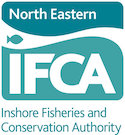Research
The Environmental and Scientific Team at North Eastern IFCA is responsible for the science-led management of the local inshore fisheries through research in areas of fisheries science and marine conservation. Current and past research includes mapping and assessment of marine habitats, biology and ecology of lobster, population structure and dynamics of lobster and edible crabs and improvements of fishing gear. Further responsibilities include the monitoring of important areas of conservation and investigating incidents that may pose a threat to marine life. Research conducted by NEIFCA includes both sea-based and land-based survey work to gather data for scientific analysis, which aids in the development of management strategies for a range of marine resources.
Shellfish Potting Surveys
Throughout the summer months potting surveys are conducted onboard the North Eastern Guardian III to collect data on the local crab and lobster populations. These surveys use commercial pots without escape gaps to sample a greater size range of crab and lobster than can be obtained from quayside sampling, where only marketable sized catch can be measured. The data gathered during these surveys is then included in the annual stock assessment to determine the status of crab and lobster stocks across the NEIFCA district. Crab and lobster landings are also sampled monthly across the major ports in the North East (Bridlington, Scarborough and Whitby), the data from this quayside sampling is shared with the Centre for Environment, Fisheries and Aquaculture Science to inform stock unit level assessments. Additional fleets are worked within and in the vicinity of the permitted dredge areas in order to monitor any impacts arising from the scallop fishery.
Scallop Surveys
The North East of England is also home to a King scallop fishery, and there are currently three active scallop fishers in the NEIFCA district due to a reduction in the number of permits issued to combat the decline in king scallop stocks. Sampling is conducted in the months prior to and after the end of the permitted fishing season which runs from 1st of November until the 31st of April each year. Standard Newhaven dredges are used onboard the North Eastern Guardian III to complete scallop surveys with data gathered on scallop width and age and the abundance of species caught as bycatch. Throughout the permitted fishing period, Environmental Officers carry out industry-based surveys by gathering additional data from onboard the permitted scallop fishing boats. Scallop age and size frequency data collated from scallop surveys are used to complete annual stock assessments for King scallop within the district.
Cockle Monitoring Surveys
Since the closure of cockle beds within the district due to overexploitation, a monitoring program has been implemented to assess whether the closure is benefitting the stock. Cockle surveys are carried out bi-annually across three sites; Bran Sands, Middleton Basin and Wonderland (Cleethorpes). From these monitoring surveys it is possible to identify changes in the spatial extent of cockle beds, population length and age structure and estimate the density and biomass of cockles within each bed.
Spurn Point Seagrass Monitoring Surveys
The Spurn Point Seagrass Area is located within the Humber Estuary European Marine Site and is protected under the Humber Estuary Byelaw XXIX which prohibits trawling, digging, netting, longline fishing, dredging and the use of pots or traps within the area of seagrass. Monitoring of the common eelgrass bed (Zostera spp.) is carried out annually to assess the effectiveness of this byelaw by identifying any changes in spatial extent to the seagrass bed and by estimating density and biomass of Zostera spp. within the bed.
